All Cannings
All Cannings (pronounced Allcannings) is a village and civil parish in the Vale of Pewsey in the English county of Wiltshire, about 4 miles (6 km) east of Devizes.
| All Cannings | |
|---|---|
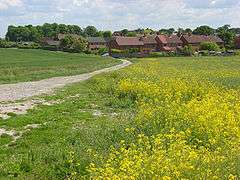 The edge of All Cannings | |
 All Cannings Location within Wiltshire | |
| Population | 649 (in 2011)[1] |
| OS grid reference | SU070617 |
| Civil parish |
|
| Unitary authority | |
| Ceremonial county | |
| Region | |
| Country | England |
| Sovereign state | United Kingdom |
| Post town | Devizes |
| Postcode district | SN10 |
| Dialling code | 01380 |
| Police | Wiltshire |
| Fire | Dorset and Wiltshire |
| Ambulance | South Western |
| UK Parliament | |
| Website | Community Portal |
The parish includes the nearby smaller settlement of Allington.
History
The earliest settlement in the area of All Cannings was at Rybury Camp, on the downs above the village.
The Iron Age settlement at the farm of All Cannings Cross is an important site in study of that period.
There is also evidence of settlement from Neolithic and Roman times. The Wansdyke crosses the parish, below Tan Hill.
The toponym is believed to be a derivation of "Old Canning" and a village probably existed on the current site by the 10th century as the invading Danes at that time referred to Canning Marsh.
There was a church from early in the 13th century and the earliest features in the current Church of England parish church are late Norman.
By the 14th century the village had a water mill, but this had disappeared by the 18th century.
Religious sites

The Church of England parish church of All Saints is Grade II* listed.[2] It dates from the 13th century and was restored in the 19th century.[3] The church has a cruciform shape with a three bay nave, a central tower, north and south transepts, a south chapel, north and south porches, and a 19th-century chancel.
Norman features remaining include part of the chancel arch. The three stage Perpendicular tower is the mid 15th century; the transepts also date from this period. It is believed that the nave and aisles were re-modelled after the Reformation.
There was a church at Allington before 1100 but it fell into disuse, possibly in the 14th century.[4]
Bethel Strict Baptist chapel opened at Allington in 1828 and is still in use.[5] A Wesleyan Methodist chapel was registered in 1890 and closed sometime before 1959.[6]
Education
All Cannings had a Sunday school by 1808 and a day-school by 1818.[7] 100 pupils were enrolled in the day-school but attendance was much less as many of the children worked in the fields during the week.[7]
By 1833 the village had two-day-schools: the parish school with 105 pupils and a private school with 12 pupils.[7] The Rector had the parish school built that year on land given by the Lord of the Manor, Alexander Baring.[7]
The private school had closed by 1858.[7] The parish school was reorganised in 1961[7] and moved into a new building in 2000.[8][9]
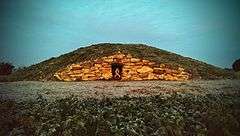
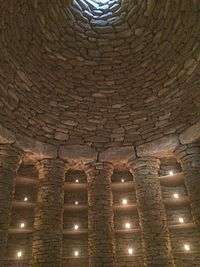
Modern Long Barrow
In 2015 the first long barrow in thousands of years, inspired by those built in the New Stone Age, was built on land just outside the village. The project was instigated by Tim Daw, a local farmer and a steward at Stonehenge.[10]
The barrow was designed to have a large number of private niches within the stone and earth structure to receive cremation urns.
The structure received significant media attention as it was being built, and was fully subscribed within eighteen months.[11]
Rock Against Cancer Concert
The Kings Arms public house hosts an annual "Rock Against Cancer" concert. Artists at the 2012 event included:[12]
- Bob Harris (compere)
- Mike + The Mechanics
- Brian May
- Kerry Ellis
- Madeline Bell
- Midge Ure
- Tom Robinson
- Chris Thompson
- Patti Russo
- Sweet
- Strawbs
Early concrete housing
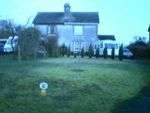
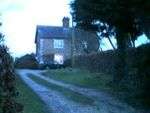
The Kennet and Avon Canal was built just north of the village and opened in 1810. The village's population peaked in the middle of the 19th century with the 1841 census showing 663 inhabitants.[1]
In 1868 Francis Baring, 3rd Baron Ashburton, and his tenant farmer Simon Hiscock decided to each build a pair of semi-detached workers cottages. They had two adjacent plots of the same size.
The tenant built his pair of brick, his Lordship of concrete – the only major difference is that in the absence of internal shuttering the concrete chimneys are straight rather than bent to combine into a single chimney stack.
Both pairs of cottages still stand largely unaltered, although one of the concrete houses had an extension added in June 2006.
It is assumed that this was a trial into the efficacy of using shuttered reinforced concrete as a building method. It seems to have been successful as two more pairs were then built, followed by a more elaborate villa style pair of cottages and finally a large Farmhouse.
This experiment is little acknowledged outside the area. While these houses may not be the very first concrete houses built, they were built within a couple of years of the first one – the time-line is not clear and are certainly the biggest example of a group of dwellings built then.
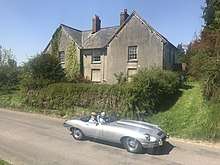
Notable people
- David Curwen (1913–2011) built miniature railway steam locomotives at All Cannings.
- Andy Scott (born 30 June 1949), guitarist with band The Sweet, and as of June 2020, the last surviving member of their 'classic lineup', lives in a converted barn at the village.[14]
References
- "Wiltshire Community History – Census". Wiltshire Council. Archived from the original on 4 March 2016. Retrieved 22 August 2015.
- Historic England. "Church of All Saints, All Cannings (1365955)". National Heritage List for England. Retrieved 22 August 2015.
- "Church of All Saints, All Cannings". Wiltshire Community History. Wiltshire Council. Archived from the original on 23 October 2015. Retrieved 22 August 2015.
- "Victoria County History – Wiltshire – Vol 10 pp20-33 – Parishes: All Cannings". British History Online. University of London. Retrieved 22 August 2015.
- "Bethel Strict Baptist Chapel, Allington". Wiltshire Community History. Wiltshire Council. Archived from the original on 23 October 2015. Retrieved 22 August 2015.
- "Wesleyan Methodist Chapel, All Cannings". Wiltshire Community History. Wiltshire Council. Archived from the original on 22 October 2015. Retrieved 22 August 2015.
- Crittall et al., 1975, pages 20–33
- All Cannings C of E Primary School
- "All Cannings C. of E. Primary School". Wiltshire Community History. Wiltshire Council. Archived from the original on 23 October 2015. Retrieved 22 August 2015.
- Middleton, Christopher. "Stonehenge steward builds his own burial chamber". The Daily Telegraph. Retrieved 5 June 2020.
- "Archived copy". Archived from the original on 12 February 2017. Retrieved 11 February 2017.CS1 maint: archived copy as title (link)
- "Concert at The Kings". Concerts at the Kings Arms Ltd. 2013. Retrieved 29 May 2013.
- Long Piddle, Burghclere Bottom, Scouses Corner, on the north side of the Kingsclere and Sydmonton road, Old Burghclere, Hampshire.
- "Sweet guitarist adds glam to fence shop opening". The Wiltshire Gazette and Herald. Retrieved 28 March 2018.
Sources and further reading
- Crittall, Elizabeth (ed.); Baggs, A.P.; Crowley, D.A.; Pugh, Ralph; Stevenson, Janet H.; Tomlinson, Margaret (1975). Victoria County History: A History of the County of Wiltshire: Volume 10: South-west Wiltshire: Chalke and Dunworth hundreds. pp. 20–33.CS1 maint: extra text: authors list (link)
- Pevsner, Nikolaus; Cherry, Bridget (revision) (1975) [1963]. The Buildings of England: Wiltshire. Harmondsworth: Penguin Books. pp. 85–86. ISBN 0140710264.
External links
| Wikimedia Commons has media related to All Cannings. |
- "All Cannings". Wiltshire Community History. Wiltshire Council. Archived from the original on 4 March 2016. Retrieved 22 August 2015.
- All Cannings Village history page, retrieved 25 September 2012
- [All] Cannings in the Domesday Book
- Allington in the Domesday Book